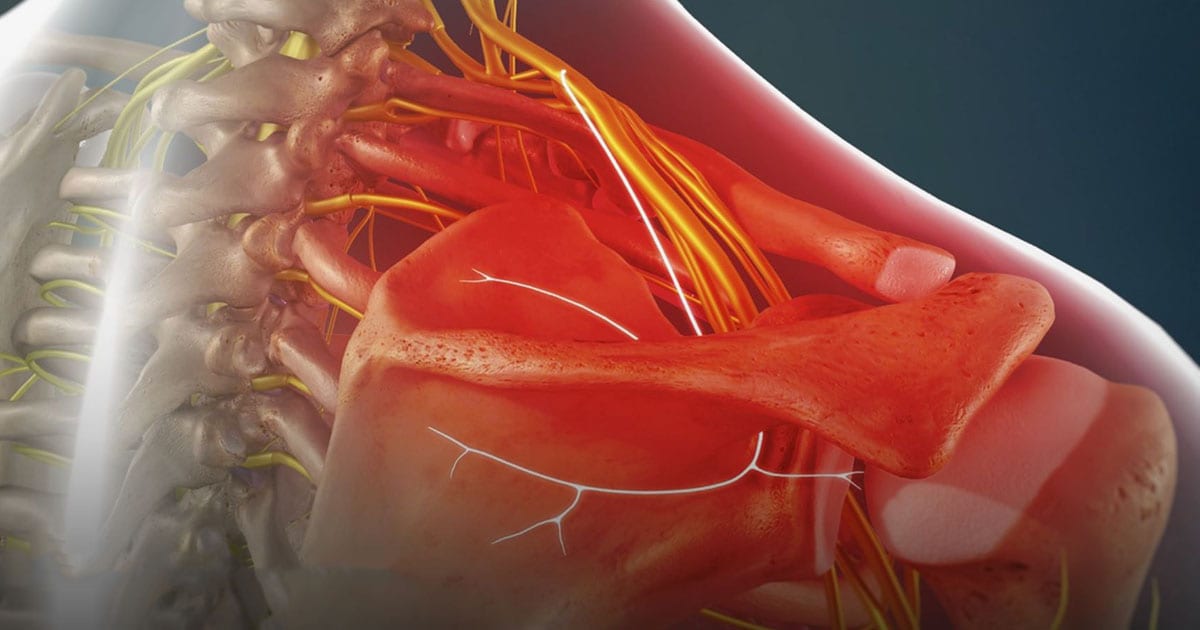
Chronic shoulder pain is as common as it is sometimes difficult to treat. These issues represent about 16 percent of all musculoskeletal complaints, emerging from a broad range of injuries, bouts with osteoarthritis or cases of frozen shoulder.
In some cases, more than one underlying problem can cause shoulder pain – and some patients are not good candidates for surgical procedures. In today's blog post, Dr. Richard C. Robertson discusses the complex process of diagnosing and treating shoulder pain.
The Slow Grind Into Chronic Shoulder Pain
No one suddenly wakes up with chronic shoulder pain. It's a condition that is years in the making. Unfortunately, as time moves forward, many treatment options fall by the wayside.
“Patients with serious shoulder pain go see a surgeon and are told, ‘Yes, you have this problem but I’m not going to operate on you,’” says Dr. Robertson. “So, patients end up with this chronic, life-altering pain. They lose range of motion in their shoulder. They lose the ability to reach above their head, or reach out to grab things. It’s very debilitating, and obviously impacts their quality of life, and their ability to do things that they want and need to do on a day-to-day basis.”
Treatment Options for Non-Surgical Candidates
The Segura Neuroscience and Pain Center offers relief for patients who may not be candidates for traditional shoulder surgery. One such option is radiofrequency ablation. With this procedure, a current produced by a radio wave heats up the suprascapular nerve, decreasing pain signals for those suffering from chronic shoulder pain.
“The suprascapular nerve, which senses a lot of the pain that these patients have, goes out to the shoulder joint itself, and to several of the muscles that are in the shoulder joint,” Dr. Robertson says.
“By heating up that nerve,” he adds, “it is prevented from sending a pain signal from the shoulder to the brain telling you that your shoulder hurts. I explain to people that it’s a lot like taking a section out of a train track. The train can run up and down the track, as long as all of the segments are in place. But if you remove a portion of that track, the signal can’t be sent anymore. By doing that, we can give people prolonged relief.”
"An ablation prevents the nerve from sending a pain signal from the shoulder to the brain."Richard C. Robertson, MD
How Long Can a Treatment for Chronic Shoulder Pain Last?
The first step in treating chronic shoulder pain is to determine if the patient is a good candidate for a radiofrequency ablation. A test injection of numbing medicine is administered with a small acupuncture-style needle to the suspected nerve. If this treatment provides more range of motion and less pain, then the focus turns to disruption of the nerve signals through ablation.
Whereas the numbing medicine may give up to a few hours of relief, ablation can provide extended periods of relief from shoulder pain – perhaps as long as a year. “Every patient is different. While I can’t always say you’re going to get 12 months of relief. Some patients get longer than that, while some get less,” Dr. Robertson says.
The procedure can also be repeated, as necessary. “If the pain comes back in 6 or 12 months,” Dr. Robertson says, “you can go back and do the procedure again, and you’ll get that same long-lasting relief.”
"The first step in treating chronic shoulder pain is to determine if the patient is a good candidate for a radiofrequency ablation."Richard C. Robertson, MD
Is there a Danger of Reinjury Following Treatment?
Patients can be perhaps understandably reluctant about getting back to normal activity. “There can be a certain hesitancy, because you’ve done something and it’s always hurt in the past,” Dr. Robertson says.
Still, he advises those suffering from chronic shoulder pain to return to as much normalcy as they can after receiving treatment like radiofrequency ablation.
“Try to become as functional as possible – because what you see is, patients who don’t use their shoulder, the muscles become degenerated,” Dr. Robertson says. “That debilitation developed because of the pain, so if we can get that pain under control, then they can get back to doing what they need to do. A lot of times, if I can get people out of pain and get them some relief, I’ll get them into physical therapy and they can rebuild some of that muscle.”
"If I can get a patient out of pain, they can rebuild muscle."Richard C. Robertson, MD
What if There is More Than One Problem?
Frequently, patients with chronic shoulder pain are actually suffering from multiple issues. Once one symptom is resolved, a process called unmasking can take place – and suddenly they notice another problem.
“Once we take care of one source of pain,” Dr. Robertson says, “patients complaints will change. They’ll say, ‘That’s better, but it still hurts over here.’ That allows us to rule things out, and address it if there are other issues. We see that very, very commonly: Once one thing is under control, they realize, ‘This hurts, as well.’ When you have that primary pain generator, and that’s the only thing you can focus on, that’s the thing that interferes with your quality of life. Getting that under control allows us to refocus on other things that are bothering the patient.”
Older, underlying injuries can lead to shoulder pain. Bulging discs are quite common, for instance, but they’re typically undiagnosed until a patient reports pain somewhere else.
“Our parts have a limited warranty. Ultimately, wear and tear gets us,” Dr. Robertson says. “There certainly is also trauma, people that are involved in car wrecks or falls, or injuries on the job. Inevitably, it’s some combination.”
Finally, pain can mask itself, as when a cervical issue mimics a shoulder injury because of a radiating pain response. These shoulder pain issues are addressed one by one at the Segura Neuroscience and Pain Center, as needed.
"Once one symptom is resolved, a process called unmasking can take place."Richard C. Robertson, MD
Is a Radiofrequency Ablation Right for You?
If conservative approaches like epidural steroid injections or physical therapy haven't resolved your chronic shoulder pain, and you are not a candidate for shoulder surgery, a radiofrequency ablation may be ideal for you.
Contact us today to schedule an appointment with Dr. Segura or Dr. Robertson. They can identify the root cause of your shoulder pain, review your history and treatments, and outline a plan for you.
About Dr. Robertson

Dr. Richard C. Robertson, Jr., MD
Richard C. Robertson, MD is is double board certified in anesthesiology and interventional pain management.
Dr. Robertson served as a board member of the Mississippi State Medical Association and was chosen to receive both the Virginia Stansel Tolbert Award and the Carl Gustav Evers Award for outstanding leadership. He chose to further specialize his training by completing an ACGME-accredited fellowship in interventional pain management at Wake Forest University Baptist Medical Center in Winston-Salem, NC.
This website is not intended to provide specific medical advice, medical diagnosis, opinion, treatment or services to you or to any other individual. Through this website and links to other websites, Segura Neuroscience & Pain Center provides general information for educational purposes only. The information provided in this site is not a substitute for medical or professional care. You should not use this information in place of the advice of your physician or other healthcare provider. Segura Neuroscience & Pain Center is not liable or responsible for any advice, course of treatment, diagnosis or any other information, services or product you obtain through this website.
